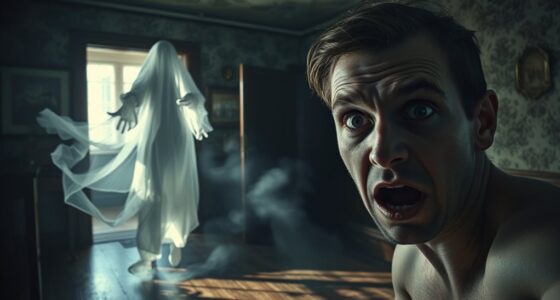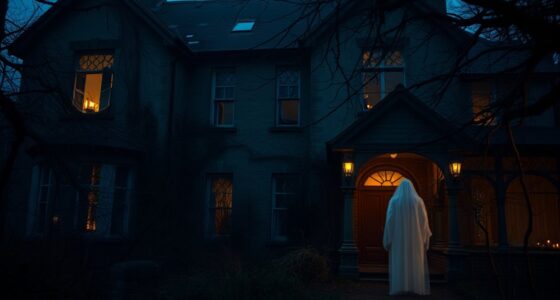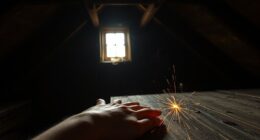The case of Roland Doe is one of the most famous stories of alleged possession and exorcism. You learn that strange noises, moving objects, and personality changes started around him, prompting investigations into medical and psychological causes. Exorcists performed structured rituals with prayers, aiming to banish the malevolent presence. Eyewitness accounts vary from fear to awe, fueling public debates about whether it’s supernatural or psychological. If you explore further, you’ll uncover the deeper mysteries behind this intriguing case.
Key Takeaways
- Roland Doe, also known as Robbie Mannheim, was the boy at the center of the famous 1949 exorcism case in Maryland.
- His family reported paranormal phenomena, including strange noises, movements, and personality changes, prompting an investigation.
- Medical and psychological evaluations were conducted to rule out mental health issues before an exorcism was performed.
- The exorcism was carried out by Catholic priests, involving traditional prayers, rituals, and spiritual commands to expel the entity.
- The case inspired the book and film “The Exorcist,” fueling public fascination with demonic possession and exorcism practices.
The Background of Roland Doe

To understand the infamous case of Roland Doe, it’s essential to know his background and the circumstances that led to his possession allegations. Roland was a young boy from Maryland whose family became intrigued by psychic phenomena and paranormal research. After experiencing strange occurrences in their home, they sought help from local experts, believing supernatural forces might be at play. These events sparked widespread interest, attracting the attention of investigators and religious figures. As reports of unexplained noises, moving objects, and eerie sensations grew, the family’s concern deepened. The case drew attention from those involved in studying paranormal phenomena, fueling debates about whether these occurrences were genuine supernatural events or psychological in nature. Roland’s story became a focal point for discussions about the reality of possession and spiritual intervention. Additionally, modern AI technology has been used to analyze similar cases, aiming to distinguish between psychological explanations and potential supernatural influences. Understanding paranormal phenomena can help contextualize the events surrounding Roland and similar cases, providing insights into both psychological and spiritual perspectives. Furthermore, advances in scientific analysis continue to shed light on these mysterious cases, offering new ways to interpret the phenomena.
The Early Signs of Possession

Early signs of possession often manifest through inexplicable behaviors and physical phenomena that unsettle those around you. You might notice sudden changes in personality, strange sounds, or unexplained movements. These supernatural phenomena can include objects moving on their own or eerie noises. Sometimes, psychological factors play a role, making it hard to distinguish between mental health issues and true possession. Recognizing these early signs helps you understand if supernatural influences are at play. Here’s a quick overview:
| Behavior | Physical Phenomena | Psychological Factors |
|---|---|---|
| Sudden aggression | Unexplained noises | Anxiety or delusions |
| Fear without cause | Objects moving mysteriously | Hallucinations |
| Withdrawal from loved ones | Unusual bodily movements | Mood swings |
Stay alert to these signs, but remember, interpretation requires careful consideration. Being aware of psychological factors can help distinguish between mental health issues and supernatural influences, encouraging a balanced and mindful approach to these phenomena. Recognizing that early signs of possession may resemble mental health symptoms underscores the importance of a thorough evaluation before drawing conclusions. Additionally, understanding cultural beliefs about possession can provide valuable context and aid in accurate assessment. Being mindful of spiritual interpretations can also deepen your understanding of these phenomena and how they are perceived across different traditions.
The Investigation and Medical Explanations

When confronting reports of possession, investigators often rely on a combination of medical examinations and psychological assessments to determine the cause of strange behaviors and phenomena. Many skeptics emphasize medical skepticism, suggesting that neurological or physical issues might explain what appears supernatural. Psychological explanations also play a significant role, as mental health conditions like schizophrenia or dissociative disorders can produce symptoms that resemble possession. During the investigation of Roland Doe, doctors conducted numerous tests, often ruling out physical illnesses. However, some experts remain cautious, arguing that certain symptoms could be attributed to psychosomatic factors or suggestive beliefs. This approach aims to differentiate genuine supernatural activity from medical or psychological conditions, ensuring a thorough, rational assessment before considering any spiritual or ritualistic explanations. Additionally, understanding the maintenance and troubleshooting of investigative tools can be crucial in ensuring accurate assessments. Proper calibration and understanding of the contrast ratio and other technical specifications of equipment help prevent misinterpretation of data, which is essential in such sensitive investigations. Incorporating a comprehensive diagnosis approach can further enhance the accuracy of distinguishing between medical, psychological, and spiritual factors, especially when applying principles from ethical hacking to ensure data integrity and security. Recognizing the importance of interdisciplinary collaboration among experts can also improve the reliability of conclusions drawn during such investigations.
The Exorcism Rituals Performed

You’ll see that exorcism rituals follow specific steps and sequences, designed to confront the entity. Priests use particular prayers during the process, each with a distinct purpose. Understanding these rituals reveals how the church attempts to banish the supernatural presence. Support hours for clergy performing these rites are often carefully coordinated to ensure proper procedures are followed. Additionally, Remote Hackathons are increasingly utilized by organizations to facilitate collaboration across distances, which can be adapted to coordinate and support these complex rituals when needed. Recognizing the importance of ritual structure helps ensure that each step effectively addresses the spiritual challenge at hand. Incorporating visual and auditory cues can enhance the effectiveness of the rituals by focusing concentration and reinforcing the steps involved.
Ritual Steps and Sequence
The exorcism ritual performed on Roland Doe followed a structured sequence designed to confront and banish the malevolent entity. You’ll notice that exorcism techniques involve precise actions, prayers, and gestures, all rooted in ritual symbolism. The process begins with an assessment of the situation, followed by prayers of protection and invocation. The priest then uses holy objects, such as crucifixes and relics, to create a sacred space. Ritual symbolism plays a vital role, representing spiritual authority and divine power. The sequence continues with commanding the spirit to depart through specific words and gestures, intensifying the confrontation. Each step aims to weaken the entity’s hold, ultimately leading to its expulsion. This ordered approach reflects both tradition and spiritual authority inherent in exorcism procedures.
Priests’ Specific Prayers
Priests performing exorcisms rely heavily on specific prayers that serve to invoke divine authority and confront the malevolent spirit. These prayers are carefully chosen, often rooted in traditional exorcism terminology, to establish spiritual dominance over the entity. The prayers’ effectiveness depends on their precise recitation, ensuring the exorcist’s words resonate with divine power. Common exorcism prayers include the “Vade Retro Satana” and the “Prayer to St. Michael,” which are believed to weaken the spirit’s hold. During the ritual, the priest’s firm voice and authoritative tone reinforce the spiritual command. By adhering to these specific prayers, the priest aims to create a spiritual barrier, compelling the spirit to depart and restoring peace to the afflicted individual.
Eyewitness Accounts and Testimonies

You’ll find that eyewitness accounts vary widely, with some describing frightening personal encounters that seem almost beyond belief. As you examine these stories, consider how the credibility of each witness impacts the overall case. Their firsthand testimonies can either strengthen or challenge the authenticity of the exorcism experience.
Personal Encounter Descriptions
Many who witnessed the events at Roland Doe’s house describe a chilling atmosphere filled with unexplained noises, objects moving on their own, and sudden, violent outbursts. These personal encounters often involve reports of supernatural phenomena that defy logical explanation. Witnesses recall hearing disembodied voices, seeing furniture shift without cause, and experiencing intense feelings of dread. Some believe these accounts point to genuine supernatural activity, while others suggest a psychological analysis might explain the behaviors. The witnesses’ descriptions emphasize a sense of real fear and confusion, leaving a lasting impression. Whether rooted in supernatural forces or psychological distress, these testimonies offer a compelling glimpse into the intense and unsettling experiences that marked this haunting.
Credibility of Witnesses
The credibility of witnesses who reported supernatural events at Roland Doe’s house hinges on the consistency and detail of their accounts, yet these testimonies often vary in reliability. Psychological factors, such as fear, suggestibility, or personal belief systems, can influence what witnesses recall and how they interpret events. Additionally, legal considerations come into play when evaluating the validity of their testimonies, especially in courtrooms or formal investigations. You must consider whether witnesses might have been influenced by external pressures or internal biases, which could distort their perceptions. This makes it challenging to establish absolute certainty about the supernatural nature of their claims. Ultimately, understanding these factors helps you assess the strength of eyewitness accounts and the overall credibility of such testimonies.
The Aftermath and Public Reaction

In the wake of the exorcism involving Roland Doe, public reaction was swift and intense, reflecting both fascination and skepticism. You notice how media coverage fuels curiosity, with headlines highlighting the mysterious events and spiritual controversy. Public perception varies—some see it as proof of supernatural forces, while others dismiss it as hysteria or hoaxes. The media amplified the story, shaping opinions and stirring debates. Here’s a glimpse of how different groups responded:
| Supporters | Skeptics |
|---|---|
| Believe in spiritual warfare | Question the authenticity |
| See exorcism as divine intervention | Attribute events to mental health or trickery |
| Advocate for faith-based explanations | Demand scientific evidence |
Debates Over Authenticity and Skepticism

Debates over the authenticity of Roland Doe’s exorcism continue to divide opinions, with skeptics questioning whether the events were genuinely supernatural or simply the result of psychological or theatrical factors. Many argue that supernatural claims can often be explained through natural causes, such as mental health issues or suggestibility. Scientific skepticism challenges the idea that the exorcism involved real supernatural forces, pointing out inconsistencies and the lack of verifiable evidence. Skeptics also highlight the possibility of staged or exaggerated events to attract attention. On the other hand, believers see the phenomena as proof of supernatural activity, reinforcing the idea that some events transcend scientific understanding. Ultimately, the debate remains unresolved, fueling ongoing discussions about faith, perception, and the limits of scientific explanation.
The Legacy and Cultural Impact

As discussions about the event’s authenticity continue to spark skepticism and belief, the case of Roland Doe has left a lasting mark on popular culture and religious communities alike. You can see its influence in movies, books, and TV shows that depict exorcisms, often referencing the spiritual symbolism associated with the case. The story has shaped how society perceives the battle between good and evil, embedding itself into horror genre themes. Its portrayal in media has fueled both fascination and fear, reinforcing the idea of spiritual warfare. For many, the case symbolizes the mysterious power of faith and the unseen forces at play, making it a cultural touchstone that continues to inspire discussions on spirituality, doubt, and the supernatural.
Frequently Asked Questions
What Happened to Roland Doe After the Exorcism Concluded?
After the exorcism, you might wonder about Roland Doe’s paranormal aftermath and spiritual recovery. Although details are scarce, it’s believed he experienced ongoing struggles with the effects of the demonic possession. You’d likely see him trying to regain normalcy, seeking spiritual healing, and overcoming the trauma. The case highlights how such experiences can leave lasting impacts, making recovery a complex, ongoing process for those involved.
Were Any Physical Injuries or Damages Reported During the Possession?
Imagine witnessing shadows twist and objects shatter as unseen forces swirl around you. During the possession, reports of paranormal injuries surfaced, with individuals experiencing scratches and bruises, while property damage became evident—furniture moved on its own, windows shattered mysteriously. These signs of haunting left a trail of chaos, revealing the intense and unsettling presence of supernatural forces at work, leaving everyone involved questioning what was truly happening.
How Did the Church Officially Verify the Case’s Authenticity?
You wonder how the church verifies a possession case’s authenticity. They rely on thorough investigative procedures, including detailed church documentation of the events, testimonies, and evidence collected. Officials scrutinize the signs, symptoms, and behaviors witnessed, ensuring consistency with possession phenomena. This rigorous process helps confirm the case’s legitimacy, preventing false claims and ensuring that any exorcism performed aligns with church protocols and standards for such sacred procedures.
Are There Comparable Cases Similar to Roland Doe’s Story?
You might wonder if there are comparable cases involving demonic possession and supernatural phenomena. Many stories across different cultures and times describe similar experiences, where individuals exhibit unexplained behaviors or ailments. These cases often involve alleged demonic possession, prompting exorcisms or spiritual interventions. While some are documented as authentic, others remain controversial or unverified. Exploring these cases can offer insight into how different societies interpret supernatural phenomena and their efforts to address them.
What Were the Long-Term Psychological Effects on Roland Doe?
Imagine a storm lingering after the skies clear—that’s how you might see Roland Doe’s long-term psychological trauma. The haunting experience left lasting scars, triggering behavioral changes and deep emotional wounds. You’d notice persistent fear, trust issues, and sometimes hallucinations, as if shadows from the past still whisper. His mind carried the weight of that battle, shaping his future in ways that revealed the profound and lasting impact of the ordeal.
Conclusion
You can’t help but feel the weight of history pressing down as you consider Roland Doe’s case—an event so enigmatic, it rivals the mysteries of the universe itself. Whether you believe in the supernatural or see it as psychological, one thing’s certain: this story’s shadow looms large, challenging your understanding of reality. It’s a haunting reminder that some mysteries are so profound, they threaten to unravel the very fabric of what you think you know.









